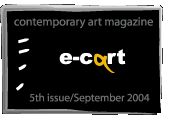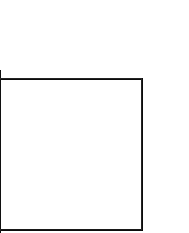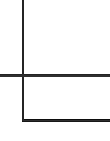Looking from the dark, un-inhabiting the camera obscura
Bogdan Teodorescu, Art's speosophy, 14 - 23 June 2004, Vector> Gallery, Iasi
Conventionally, an art exhibition is perceived as a space of presentation for the art works or as an opportunity to meet the art's audience. Challenging this convention, Bogdan Teodorescu used the space of Vector> Gallery in Iasi also as a place for producing his photographic works, transforming it into a "working studio" in which he submitted to analysis and execution his own artistic experiences as well as his daily and historical reflections in relationship with the materials and people around him.
The exhibited photographs seem to have been selected from a film archive, thus quoting in a static way the dynamics of art work's producing. However, visiting the exhibition at the opening, the viewer could meet in the gallery characters that appeared in the photos, pointing out at the artist's practice of inviting his friends as circumstantial actors and of directing his photographic sessions as on a shotting stage.
For Bogdan Teodorescu, any work of art and, implicitely, any exhibition requires a multitude of levels of reception that provokes the public to look at the aesthetics of the works, to reflect at their sense and to involve in a relation of communication. As a whole, his exhibition is an ecclectic collection of works and experiences, of daily and historical references, of metonimic sequences captured from a film of the artis's life. In detail, photography, as an artistic medium, is the instrument of inquiring into the technical and thematic experiment.
The arrangement of the works at the height of 1,76 meters (equivalent of the artist's height) is constituting as an allusion to the relationships with that people who cannot hold his look, trying to point it on a flaw, in this case the top of his head. For the artist this is not a flaw and, precisely for that, he invites his public to look at his works at the height of the place where meetings and concepts are produced.
At the entrance, a first work, representing in black and white a traffic light with three lamps and the marginal ones switched on, speaks about the paradoxical character of the art work, which is showing and hiding itself at the same time, which allows and forbiddens, at the same time, the access to a full understanding.
The second work reinterprets the visual and theoretical "origin" of the contemporary art history through an ironic allusion to the often quoted "Fountain" of Marcel Duchamp, which from an urinal for men transformed into one for women onto which the "MUTE" signature is painted, that graphic icon which also appears as a signature, but an electronic one, in the corner of the TV screen when something is put under silence. Upset that this is not an "authentic interpretation" of Duchamp's work, as they didn't find the three-dimensional object but a two-dimensional reproduction of the object found and signed by Teodorescu, some visitors had to take back their refrains when they found out that it was an allusion to the photographic reproduction of Alfred Stieglitz through which we are aquintated with an object that no longer exists.
The series of four photographs "I like... this bed... and this bed... likes me" represents a "stage on the screen" of a succession of states we can read on the face of a character lain on the bed, under a satin sheet. "The model" expresses herself in front of "the artist" through sleep, dream, awakening, eroticism, respectively through the rest on the surface of the reverie and the wakefulness that emanates seduction.
The series of photos that gives the title of the exhibition, "Art's speosophy", interprets the platonic myth of the cave from the perspective of the contradictory relationship between the artist and the viewer, whether this one is a theoretician, a critic or anyone else. The artist uses hands as an instrument of work, representing shadows of a vision. Who creates "shadows"? The hands (manufacture) or the looks (contemplation)? Creation and the looks meet in the dark room of the photo camera. Using the familiar myth of the cave seems to hint, at the same time, at the hybrid creation of an art theory at the edge of philosophical discourse and artistic practice.
In a juxtaposed work we have the image of the artist who produces the artist as an art work, the artist-work coming out of the black box of the video camera in a magical act. "The power is in my hand" is one of the instrumental concepts of the artist Bogdan Teodorescu.
The next three photographs represent three types of conceptual experiments. In the first one, three test-tubes with colored liquids hint at the idea of producing light from the combination green+red+blue, artistically reflecting the scientific impossibility of obtainting liquid light. In the second one, the "white cube" of the gallery is photographically distorted to get the illusion of "spherical space", also raising the problem of exhibiting the works both in the "white cube" of the gallery and in the "black box" of the camera. Finally, in the third photograph there is a passage from the recipients used in research (test-tubes) to the recipients used in daily life (glasses), making a family portrait of these last ones. Even if the different shapes of the glasses ask for the status of connaisseur / connaisseuse in order to pour into them the right drinks (wine, brandy, liqueur, champagne, vermouth etc.), in these glasses only one liquid was poured (milk). Beyond the metaphorical value of the image, the artist speaks about the inadequacy of using different means for the same content, about the improper use of a concept through the means specific to other concepts.
In the last photographs exhibited at the Vector> Gallery in Iasi, Bogdan Teodorescu investigates three types of relationships from a performative and narrative perspective. Thus, in a first discourse, the artist analyses the relationship of the couple in its two states, from the private to the public. If in the private context the man is in a dominant relationship towards the woman, which is transformed into a domestic piece of furniture, in public the two seem to have a relationship of equality, sitted in front of each other at the same table and even exchanging privileges and drink. Beyoud the post-productive use of Allen Jones' work "Table", we find here an ironic critique of the patriarchal society in which man has an attitude of despise towards woman, even if in public the woman has priority in choosing the champagne. In the second discourse, the artist submits to investigation the relationship between father and son, by installing under the photography in which the father is sitting in the upper part of a rocking chair a wooden platform. Thus, the artist speaks about the stages that the son has to cover in order for him to gather the father's life experience. In the last series of pictures, the artist's relationship towards himself is brought to attention, in which the artist is consuming himself, self-devouring in silence.
In many of his works, Bogdan Teodorescu puts up-to-date some of the concepts and strategies of work that asserted him on the local art scene. However, this time his photo-performances are not just an object of study (as in the exhibition Performance, Cupola Gallery, Iasi, 2002, which conception is described in the magazine Observatorul cultural nr. 177, 15.07 - 21.07 2003), but become the means for expressing an art behaviour motivated to investigate a complex of situations and facts with which the artist interferes directly and suggestively.
Conceiving the exhibition as a collection of works and experiences that talk about the complexity of the artistic act, representing, at the same time, a model of the productive effort, Bogdan Teodorescu establishes a special relationship with a public who understood to visit the cave of traditional art only as a sightseeing spot, with its re-written history.
Catalin Gheorghe, theoretician and contemporary art analyst, phd student in Aesthetics and Philosophy of Art, member of the vector> group, Iasi
VECTOR> Gallery str. Cuza Vod?, nr. 41, Ia?i, cod 700 750, RO Tel/fax: +40 232 237 486 Email: vector_cartier@iasi.astral.ro
|
|
 |
|
|
|||||||||||||||||
 |
 |
 |
|
|||||||||||||||||
 |
|
|||||||||||||||||||
 |
 |
|
|
|||||||||||||||||
|
|
 |
|
|
|||||||||||||||||
|
|
|
|||||||||||||||||||
 |
 |
|
 |
|
 |
|
|
|
||||||||||||
 |
|
|
||||||||||||||||||
|
|
 |
|
|
|||||||||||||||||
|
|
|
|||||||||||||||||||
| |
|
|||||||||||||||||||
 |
|
|||||||||||||||||||
 |
|
|||||||||||||||||||
 |
|
|||||||||||||||||||
|
|
|
|||||||||||||||||||
 |
|
|
||||||||||||||||||
|
|
|
|||||||||||||||||||
|
|
 |
|
|
|||||||||||||||||
|
|
|
|
|
|
|
|
|
|
|
|
|
|
|
|
|
|
|
|
|
|